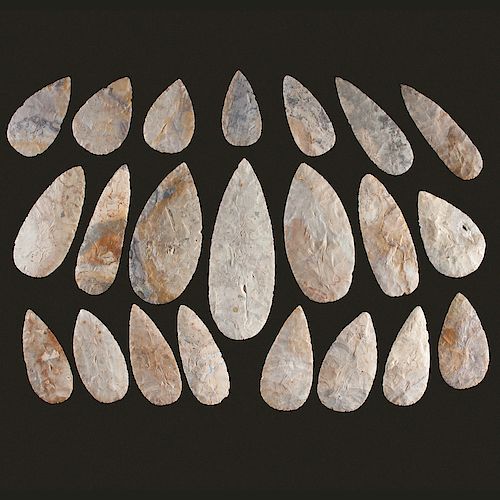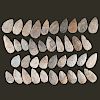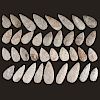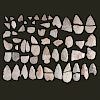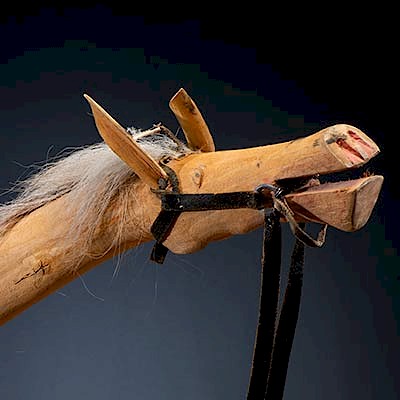A Cache of Adena Blades, The Smith Cache
About Seller
6270 Este Ave.
Cincinnati , OH 45232
United States
With offices in Cincinnati, Cleveland and Denver, Cowan’s holds over 40 auctions each year, with annual sales exceeding $16M. We reach buyers around the globe, and take pride in our reputation for integrity, customer service and great results. A full-service house, Cowan’s Auctions specializes in Am...Read more
Two ways to bid:
- Leave a max absentee bid and the platform will bid on your behalf up to your maximum bid during the live auction.
- Bid live during the auction and your bids will be submitted real-time to the auctioneer.
Bid Increments
| Price | Bid Increment |
|---|---|
| $0 | $25 |
| $500 | $50 |
| $1,000 | $100 |
| $2,000 | $250 |
| $5,000 | $500 |
| $10,000 | $1,000 |
| $20,000 | $2,500 |
| $50,000 | $5,000 |
| $100,000 | $10,000 |
About Auction
Apr 5, 2019
A large auction of over 450 lots, featuring the Southwest Collection of Harriet and Seymour Koenig, NY. Highlights of the sale also include a Dance Stick by Joseph No Two Horns (Lakota, 1852-1942), Winter Count by High Dog (Lakota, 19th/ 20th century), a Tsimshian Carved Staff, and much more. Cowan's Auctions dawnie@cowans.com
- Lot Description
Adena, Early Woodland Period, 1000 BC - AD 1
97 whole and 59 partial blades
made from colorful and richly veined Flint Ridge flint
sizes range from 2-5/8 to 8.25 in.
The Adena Cache blade is an important diagnostic trait of the Adena Culture. Some blades have been found in mounds, such as the William C. Mills discovery, where eleven blades were recovered during an excavation, near Chillicothe, Ohio in 1901. Others though, have been found in caches of 3 to well over 300 blades, in locations far from known Adena habitation sites. This was the case for the Smith Cache of Adena Blades.
William Smith, a farmer, discovered five large blades in 1968, while plowing his field. The field was located east of Deshler, Ohio in the southwest corner of Wood County, near the north branch of Portage Creek. Each spring, for the next ten years, he recovered more of these beautiful leaf-shaped blades.
In 1978, well-known Ohio collectors, Jan Sorgenfrei of Findlay, Ohio and Pete Diller of Mt. Cory, Ohio, visited Smith, purchased the blades, and received permission to look for more. Their shared efforts yielded about 150 complete and partial blades. Most of the Diller portion was auctioned in 1988 in Fort Wayne, Indiana. Likewise, many of the Sorgenfrei blades were sold privately and at auction. Still, numerous other blades were being unearthed at the Smith site. It is estimated that the Smith Cache originally contained 150 to 200 blades.
Since its dispersal, Jim Beckman of Akron, Ohio, has taken up the mantel to reassemble as much of the cache as possible. By any standards this quest has been enormously successful. Through auctions, letters, phone calls, and even rumors, Beckman has managed to locate and acquire over 100 whole, partial and pieces of the Smith Cache.
In addition to the reuniting the blades, Beckman has carefully catalogued each piece with pertinent collection history, descriptive characteristics, and any restoration notations. From his records, numerous notable artifact collections have housed specimens from the Smith Cache, including:
,br>Jan Sorgenfrei, Findlay, Ohio
Pete Diller, Mt. Cory, Ohio
Paul Nussbaum, Pandora, Ohio
Richard Sisson, Santa Fe, New Mexico
Thomas Wetherill, Boston, Massachusetts
Billie Ford, Spencerville, Ohio
Patrick Keefe, Bethesda, Maryland
Bob McGreevey, Olmstead, Ohio
Jim Johnston, Ohio
Gary Fogelman, Turbotville, Pennsylvania
Rene Battinau, Edinburgh, Indiana
Howard Steere, Manchester Center, Vermont Notes About Condition:
It is very important for any potential purchaser of the Smith Cache to know and understand the overall condition of the cache and individual blades. Mr. Beckman has objectively rated each piece in his cataloging with the following system.
Beckman Ratings with Blade Estimates
1. No Damage - 30
2. Minor Damage - 46 (20 broken and glued)
3. Average Damage -20 (15 broken and glued)
4. Major Damage - 16 (15 broken and glued)
5. Broken and Glued - (3 simply glued)
This information will be available for inspection. For a full understanding of the Smith Cache, it is essential that these blades and the Beckman catalog be personally inspected before bidding begins.
References:
Beckman, Jim. "The Smith Cache", Prehistoric Antiquities Quarterly, Vol. 16(4)
Holzapfel, Elaine. "A Study of Prehistoric Flint Caches in the Ohio Area", Ohio Archaeologist, Vol. 43(3)
Mills, William C., "Excavation of the Adena Mound", Ohio State Archaeological and Historical Publications, Vol. 10
Sisson, Richard. "The Art of Adena Cache Blades", The Ohio Archaeologist, 2005 Vol. 55(4): 4-8, illustrated pg. 93)Cowan's strives to sell only authentic artifacts. We view the sheer number of fraudulent artifacts in the marketplace a threat to the collecting hobby, and frankly, place little stock in "Certificates of Authenticity" and prefer to offer old, well-documented artifacts.Condition
We recognize that there may be disagreement between various parties regarding the authenticity of an artifact. Before placing a bid, we invite you, or a surrogate to physically examine any artifact of interest. No artifact deemed spurious by a bidder or his surrogates may be returned after the fall of the auctioneer's hammer.
As you read the catalog and examine the photographs in the catalog, please be aware that some of the artifacts in the collection have been expertly restored. While we recognize that restoration might affect the overall value of an artifact, we believe that these beautifully conserved artifacts still have high value to collectors. Wherever possible, we have noted restoration in the catalog description.
Before the sale, we welcome your questions regarding any of the lots in the catalog and will be happy to provide more photographs or descriptions.
Because of the care we have taken with these descriptions, no restored artifact may be returned after the fall of the auctioneer's hammer." - Shipping Info
-
Buyers are required to pay for all packing, shipping and insurance charges. Overseas duty charges are the responsibility of the successful Bidder. Be aware that for larger and/or valuable items, shipping charges can be substantial. - If there is no shipping amount on listed your invoice, you will need to make arrangements to pick up or ship your purchase through an alternative shipping company. Our shipping department can be contacted at 513.871.1670 (ext. 219) or email shipping@cowans.com. - Shipping charges include insurance for your order while in transit. If you have private insurance we will adjust your charge to include only packing and shipping. - Please allow 14 – 21 days after payment to package and ship your purchase as carefully as possible.
-
- Buyer's Premium



 EUR
EUR CAD
CAD AUD
AUD GBP
GBP MXN
MXN HKD
HKD CNY
CNY MYR
MYR SEK
SEK SGD
SGD CHF
CHF THB
THB